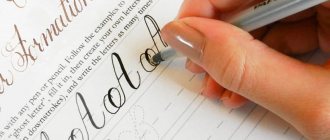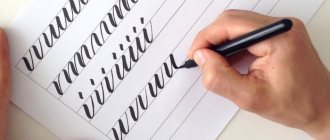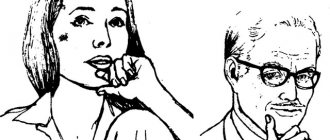On what basis do we form our opinion about a person, his character and abilities? Of course, for many reasons, among which the most significant are usually behavior, speech and appearance. However, appearances, as we know, can be deceiving, speech can be a product of learning, and it takes time to recognize people by their actions.
This is probably why there is great interest in methods for faster and more accurate analysis of a person’s inner world, not only among psychologists, personnel selection specialists, etc., but also among a wide range of readers.
There are, of course, a large number of specially created tests that allow you to identify certain personality traits. But their use (we are not talking about popular, but about professional tests) and correct analysis of the results require professional psychological knowledge and skills, so it is better to leave the possibility of their use to working psychologists. We will consider another method of obtaining information about the inner world of a person - analysis of the products of his activity. You can examine the results of creative activity (drawings, poems, stories, etc.), but not everyone has them, and besides, their analysis cannot be carried out according to a clear, unambiguous scheme. Therefore, in this article we propose to focus on adult handwriting - a product that is easy to “obtain” for analysis or even take your own sample.
Graphology, or the science of handwriting, reveals the individual characteristics of a person, which are reflected in the specific writing of letters and lines. Over the years, a certain algorithm has been developed for conducting a comprehensive analysis of handwriting. It should be noted right away that the ideal piece of text for analysis is written on an unlined sheet of paper and contains a signature.
So, before moving on to a detailed consideration, it is necessary to evaluate handwriting in three basic areas:
- harmony is the degree of harmony between the individual letters that make up words. Pay attention to the overall impression of the handwriting: does it create a sense of unity? If you are inclined to favor a positive answer, then the owner of the handwriting probably has good taste and internal culture.
- Geometric consistency of writing - evenness of lines and margins, equal distances between words and lines, uniform pressure. A high degree of this symptom indicates that a person has a large supply of internal energy, developed volitional efforts, allowing him to always maintain internal balance, inhibit unwanted emotions, and act deliberately.
- Graphological - the degree of deviation from calligraphic handwriting (which we were all taught at school). The greater this difference, the more the owner of the handwriting is inclined to show his originality and individuality in life.
Now we can move on to considering individual handwriting indicators. In general, there are a great many such indicators (including the writing of individual numbers and letters), so we will focus only on the main ones. It is important to keep in mind that you cannot draw conclusions about personality traits based on just one trait. It is necessary to take into account the entire range of characteristics being studied and the degree of their severity (just as a doctor never makes a diagnosis based on only one symptom).
Pressure when writing.
Strong pressure is usually observed in people who are energetic and enjoy showing their strength and overcoming resistance on the way to what they want.
Light pressure (thin lines, similar to intertwining threads, not noticeable from the back of the sheet) indicates the sensitivity of nature. Such people are prone to idealization and are influenced by other people's opinions, although they may well be critical. If light pressure is combined with straight lines, then this may be an indicator of a disciplined mind and the ability to generate creative ideas. If, with little pressure, the lines are uneven and individual letters are illegible, then this indicates low initiative and an inability to take deliberate volitional actions.
Sometimes there is unevenness of pressure - some words, letters or even their elements are written with strong pressure, while others are written with thin strokes. This is an indicator of imbalance, impressionability, impulsiveness of volitional acts, and the presence of internal conflicts.
If the pressure when writing is weak and, moreover, uneven, then we are most likely talking about a person who is insecure, prone to constant doubts, for whom making decisions presents significant difficulties.
If the analyzed handwriting is characterized by uniform pressure, then one can expect from its owner stability in the manifestation of his emotions, the ability to work systematically (without bursts of activity combined with periods of idleness).
Of particular interest are cases of combining different pressures when writing text and signatures. If the text is written with strong pressure, and the signature is written with light pressure, then we can assume that this person has a strong character, but for some reason wants to appear soft.
ScreenOCR - a simple online scanner of doctor's prescriptions based on photos
ScreenOCR is an application for mobile phones running Android OS. Designed to scan documentation and transcribe handwriting from photographs and digital images. With ScreenOCR you can easily recognize handwritten text in twenty languages. Main features of the application:
- automatic detection option;
- export results to .pdf and .txt formats;
- comparing the results with the original images/photos;
- scan history.
In order to recognize a doctor’s handwriting, you need to launch ScreenOCR and click on the “Upload Image” button or take a photo by pointing the camera lens at the desired area. The program has a wide range of settings and a built-in editor. The free version has a number of limitations; the paid subscription costs $9.99 per month.
Line consistency.
A “straight” line (an almost straight line can be drawn along the bottom of the letters) testifies to the balance and restraint of the writer, his ability to bring the matter to the end.
"Wavy" lines indicate that the person has flexibility of thought and diplomacy, which allows him to circumvent difficulties, although he may lack determination.
The lines that rise towards the end belong to people who are energetic, self-confident, proactive and striving for success. They may worry about their failures, but usually find the strength to make a new push towards the goal.
If the lines, on the contrary, fall towards the end, then the owner of the handwriting is characterized, accordingly, by a lack of energy to complete the task.
Physicist or lyricist
Having a sample of a person’s handwriting in hand, a graphologist can make a conclusion about the type of activity in which a person will be most effective. The handwriting of a born news journalist is different from the writing of the words of a philosophical writer.
Psychologist and graphologist Anna Strokina compared two handwritings especially for NEWS.ru.
NEWS.ru
NEWS.ru
Sample No. 1 has a social orientation, while a person with handwriting No. 2 will get tired of a lot of communication. The first number should be based on facts and figures, have a quick reaction, and be purposeful. This is evidenced by the right tilt, the predominance of straight lines, angularity, and parallelism of the lines. The second one has a hard time with strict regulation; the creative component of the work and the opportunity to experience the process are very important to him. The owner of the first example will show himself well in administration, and No. 2 is more likely to realize himself as a philosopher and writer. This is evidenced by the direct slope, the original shape of the letters, the vertical spread, and separate writing.
Anna Strokina
psychologist, graphologist
Slant handwriting.
Most people typically have handwriting with a 45-50 degree slant, but the slant can be greater (i.e., an angle less than 45 degrees). There are also upright (90 degrees) and inverted (up to 125 degrees) handwritings.
If the handwriting is too slanted, almost lying down, then its owner can be expected to display extreme traits and flaunt his feelings and preferences, as well as enthusiasm for the perception of everything new.
Handwriting tilted to the left often indicates a discrepancy between a person’s personal inclinations and the external conditions of upbringing and life. According to our observations, it is most often found in left-handed people, which, however, does not contradict the above. In right-handed people, such an inclination may indicate willfulness, stubbornness, demands on others, and distrust.
If the handwriting is vertical, i.e. has no inclination either to the right or to the left, then this indicates a balance between the mind and feelings and at the same time the restraint of a person in whose manners you will not see changes under the influence of sudden feelings or thoughts.
Variation in inclination (the presence of letters written with different inclinations) characterizes a person as capricious or subject to rapid mood swings, whose mind and emotions are in conflict.
Advertising
Psychological maturity
It is difficult to determine biological age from handwriting, but psychological age is possible. This concept denotes the degree of personal maturity, independence and self-sufficiency. The number in the passport does not play a role here. There are both infantile old people and mature students. Graphologists distinguish between “children’s” and “adult” handwriting.
We start from whether the person has mastered the writing standards proposed in the copybook. These are generally accepted average standards. If not, then the individual has not grown personally.
Tatiana Gudelova
senior psychologist of riot police (in transport) of the Main Directorate of the Russian Guard for the city of Moscow and graphologist
The graphologist said: the older a person becomes, the less “detailed elaboration” of letters and symbols, for example, curved tails, is observed in his handwriting. The writing style of a mature person is more simplified, all letters are easy to read.
NEWS.ru
The person has grown as a person. Psychological age - from 30 to 45 years. Readability, roundness of letters and their “softness”, simplification relative to copywriting standards speak of adulthood and consciousness.
Connection of letters in words.
If all the letters are interconnected, then this type of writing reflects a person’s ability to approach problems from a logical standpoint and critically evaluate them. Such a person rarely trusts his intuition.
If there are practically no connections between the letters, then the person who wrote them is not a very practical person, prone to daydreaming. It would be difficult for him to work systematically, but he can work well when inspired, especially when it comes to creativity. Such people often rely on intuition rather than logic, so the motives for their actions are not always clear to others.
beauty
Sometimes you look at a written text and admire how smoothly and beautifully it is written. All letters are identical in size, shape, and connected to each other. Behind beautiful handwriting there may be a person who does not want others to know about his inner world. In any situation, he manages to build a beautiful façade, as if he were saying: “Admire me, admire me.” He is neat and knows how to pay attention to details.
Poor handwriting, illegible, more like scribbles, speaks of an impulsive person who is capable of causing a scandal to defend his point of view. Such a person does not have time to write beautifully; his hands act slower than his brain makes decisions. Bad handwriting speaks of sloppiness, reluctance to “show off” in front of others, and nonconformism.
Sometimes you may encounter clumsy writing. The letters dance and can have different shapes, some of them are angular, others are round. There are different slants in the same text. All this speaks of disorganization, inability to deal with difficulties, and indecision. However, sometimes those with clumsy handwriting are very talented people.
From a psychological point of view, handwriting can tell a lot of interesting things about people. The way of writing reveals the secrets of character, emotional world, and personal characteristics.
Letter size.
The average height of letters is 3-4 mm; accordingly, large handwriting is considered to be one in which the letters are higher than this size, and small handwriting is lower. The width of an individual letter is usually approximately equal to its height. If the width of the letter is greater than the height, then the handwriting is called elongated, and if it is less, then it is compressed.
Large handwriting often indicates sensuality of desires, energy in communication and impracticality in life, as well as a lack of objective self-esteem.
Large and elongated handwriting may be an indicator that in life this person neglects far-fetched rules and restrictions and strives to realize himself in various types of activities.
Small handwriting is more typical for people who are reserved, observant and at the same time very private, not inclined to talk about themselves.
Concise handwriting characterizes its owner as very thrifty, economical and reserved.
Intervals
Certain distances between lines and words give characteristics about the behavior and thinking of an individual.
People who are constantly confused prefer to have small spacing between lines. Handwriting that speaks of a person who is attentive and makes informed decisions is the large spaces between the lines.
The volume of mental and physical space is shown by the intervals between words:
- A person who is able to adequately perceive the external picture and respect social inequality has the same spaces between words.
- Distances of different sizes indicate a fickle personality who communicates only with people he likes, and simply ignores the rest.
- Narrow spaces characterize a closed person who allows others to get close to him. Such a person does not require too much personal space, but prefers to be more close to other people.
- Large spaces between words reveal the owner's fear of contact with others. It will be very difficult to make acquaintance with such a person, but when approaching him, he will seem to be a rather interesting interlocutor.
Roundness of letters.
“Round” handwriting indicates a person’s tendency to soften contradictions, make compromises, and be stable in his opinions and tastes.
If you come across angular capital letters in rounded handwriting, then you are probably dealing with a rather soft person who can be persistent and aggressive in certain situations.
“Angular” handwriting indicates that its owner is characterized by harshness, demandingness, and stubbornness. However, at the same time, he has such advantages as determination, energy, and the ability to work hard. Such people often show a desire for leadership.
Advertising
Why is graphology needed?
Photo: TASS/YAY
Today, graphology is actively used in forensic and psychotherapeutic practices. Criminologists help to establish a person’s identity, other experts help to better understand oneself or decide on a career choice. In this context, it is important to understand the difference between graphology, aimed at analyzing personal characteristics through the prism of handwriting, and handwriting science, aimed at directly examining writing skills without any conclusions about the psychological portrait.
Expert opinion: Graphology and handwriting studies
IN FORENSICS:
In criminology, handwriting science is more involved than graphology. Handwriting science identifies handwritings: based on a comparative analysis, it helps to conclude whether what was written was written by the same person or not.
Handwriting is used to establish identity. Graphology, on the other hand, makes it possible to determine a psychological portrait - in forensic science, it can provide secondary values for detecting a person who is wanted.
HANDWRITING AND SIGNATURE:
In handwriting studies, handwriting and signature are considered two independent objects, equally informative. In graphology they are informative only if they are considered together. A signature is a business card that speaks about how a person wants to appear.
A signature is an image that may not correspond to real mental content. Moreover, a person can have several signatures. From a graphological point of view, handwriting provides more detailed information than a signature.
Sergey Sergeev
forensic expert, graphologist, handwriting expert
As noted by candidate of psychological sciences, graphologist Larisa Drygval, graphology is only a method of psychodiagnostics through handwriting, therefore, ideally, a good graphologist should be a professional psychologist who has completed professional retraining courses at specialized institutes, which should take at least a year and a half.
According to her, the main feature of a graphologist is the desire for knowledge. The specialist must be as impartial as possible. He should not have any sympathy or affection for the client. Each person has his own pros and cons, and the task of a graphologist is to understand the balance of these characteristics, so as not to exaggerate some and not level out others.
Expert opinion: who comes to a graphologist and why
Most often, people come to a graphologist to understand themselves - their inner world, their states. People are trying to know themselves and improve their lives in a qualitative way. Graphological analysis can help understand the causes of problems with work or personal relationships.
People also often turn to a graphologist for help with career guidance. Parents of children entering universities often come for this reason, so that the choice of institute is related to the child’s inclinations and is not forced.
A similar request comes to graphology centers from clients over 30 years of age who have already graduated, worked in their specialty and realized that this is not their profession - consultations with a graphologist help them better understand themselves and find something that would truly meet their abilities and desires.
Larisa Drygval
Head of the Center for the Study of Handwriting at the Inessa Goldberg Institute of Graph Analysis, graphologist, candidate of psychological sciences
Writing lowercase letters.
Vowels open at the top (a gap in the writing of the letters “a”, “o” at the top) are an indicator of peacefulness, gullibility and the ability to empathize, and the presence of deep attachments.
Vowels open at the bottom, on the contrary, speak of possible hypocrisy, insincerity and superficiality of feelings.
Long loops of letters (for example, “u”, “d”), reaching the bottom line or even overlapping it, indicate an intuitive beginning in a person, whose trust sometimes obscures the ability to think logically.
Small loops are evidence of conciseness in speech and deeds, realism, and the ability to speak only to the point and taking into account the place and time.
Writing capital letters.
If the capital letters are noticeably enlarged, this indicates a person’s pride (maybe even excessive), his self-confidence and independent thinking, and his desire to stand out. The desire to attract attention and sociability is also indicated by a large loop in the capital letter.
If the capital letters are relatively small in size, the person does not seek to be noticed, takes small and careful steps in life, always adhering to his convictions.
The use of printed capital letters in handwriting characterizes a person as creative, inventive, with a flexible mind and good sensitivity.
Adding eye-catching curls and other decorative elements to capital letters indicates either a need to attract attention or a romantic mindset.










